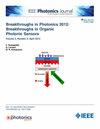Optimization of Inversion Probability Tunable Sequence Phase Modulation for SBS Suppression in Fiber System
IF 2.1
4区 工程技术
Q3 ENGINEERING, ELECTRICAL & ELECTRONIC
引用次数: 0
Abstract
Phase modulation optical spectral broadening has been widely used as an effective stimulated Brillouin scattering suppressing scheme in narrow linewidth fiber amplifiers. In particular, tunable inversion probability sequence (p-tunable sequence) phase modulation effectively optimizes the spectral envelope, improving the SBS threshold in a monolithic narrow linewidth fiber amplifier. This paper theoretically and experimentally investigates the SBS suppression capability of p-tunable phase modulation. Firstly, we introduce a theoretical model to illustrate, for the first time, the temporal and spectral properties of light waves that have been phase-modulated by a p-tunable sequence. An optimization scheme for parameter selection of p-tunable sequence phase modulation is established by calculating the SBS threshold. Meanwhile, we establish a three-stage fiber amplifier system with p-tunable phase modulation to verify our theory. The output power is 2390 W with an FWHM optical linewidth of 10 GHz. Compared to the pseudo-random binary sequence (PRBS) case, this scheme increases the output power by 700 W at 10 GHz FWHM optical linewidth.在窄线宽光纤放大器中,相位调制光光谱展宽已被广泛用作一种有效的受激布里渊散射抑制方案。其中,可调反转概率序列(p-可调序列)相位调制能有效优化光谱包络,提高单片窄线宽光纤放大器的 SBS 门限。本文通过理论和实验研究了 p 可调相位调制的 SBS 抑制能力。首先,我们引入了一个理论模型,首次说明了经过 p 可调谐序列相位调制的光波的时间和光谱特性。通过计算 SBS 门限,建立了 p 可调谐序列相位调制参数选择的优化方案。同时,我们建立了一个采用 p 可调谐相位调制的三级光纤放大器系统来验证我们的理论。输出功率为 2390 W,FWHM 光线宽为 10 GHz。与伪随机二进制序列(PRBS)情况相比,该方案在 10 GHz FWHM 光线宽下的输出功率增加了 700 W。
本文章由计算机程序翻译,如有差异,请以英文原文为准。
求助全文
约1分钟内获得全文
求助全文
来源期刊

IEEE Photonics Journal
ENGINEERING, ELECTRICAL & ELECTRONIC-OPTICS
CiteScore
4.50
自引率
8.30%
发文量
489
审稿时长
1.4 months
期刊介绍:
Breakthroughs in the generation of light and in its control and utilization have given rise to the field of Photonics, a rapidly expanding area of science and technology with major technological and economic impact. Photonics integrates quantum electronics and optics to accelerate progress in the generation of novel photon sources and in their utilization in emerging applications at the micro and nano scales spanning from the far-infrared/THz to the x-ray region of the electromagnetic spectrum. IEEE Photonics Journal is an online-only journal dedicated to the rapid disclosure of top-quality peer-reviewed research at the forefront of all areas of photonics. Contributions addressing issues ranging from fundamental understanding to emerging technologies and applications are within the scope of the Journal. The Journal includes topics in: Photon sources from far infrared to X-rays, Photonics materials and engineered photonic structures, Integrated optics and optoelectronic, Ultrafast, attosecond, high field and short wavelength photonics, Biophotonics, including DNA photonics, Nanophotonics, Magnetophotonics, Fundamentals of light propagation and interaction; nonlinear effects, Optical data storage, Fiber optics and optical communications devices, systems, and technologies, Micro Opto Electro Mechanical Systems (MOEMS), Microwave photonics, Optical Sensors.
 求助内容:
求助内容: 应助结果提醒方式:
应助结果提醒方式:


